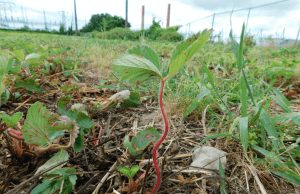Herbicide injury
Herbicide injury from hormonal disruptors such as 2,4-D, clopyralid (Stinger / Transline), and dicamba can induce curling or crinkling of leaves as an initial symptom.
2,4-D injury
2,4-D is an hormone disruptor used to control broadleaf weeds. Only amine formulations are recommended for strawberry. 2,4-D injury causes a characteristic twisting of leaf petioles. Strawberries are very tolerant of 2,4-D so will usually outgrow injury within two weeks whereas broadleaf weeds in the planting will die. Application at the wrong time can cause fasciation (cockscomb shape) in fruit, so applications during flower bud initiation or fruit development should be avoided.
Clopyralid (Stinger / Transline) injury
Clopyralid (Stinger / Transline) Clopyralid is a hormone disruptor that has a similar mode of action to 2,4-D, but clopyralid is effective against a smaller subset of weeds. Clopyralid is recommended to remove legumes, knotweeds, and members of the sunflower family. Clopyralid is readily taken up by strawberry and will travel through the vascular system. Strawberries are much more tolerant of clopyralid than many other broadleaf weeds; hence, selectivity for control. Clopyralid injury in strawberry initially causes upward curling of leaves and twisting of stems, but if the rate was appropriate, plants will grow out of the injury.
 Clopyralid injury in strawberry initially causes upward curling of leaves and twisting of stems.
Clopyralid injury in strawberry initially causes upward curling of leaves and twisting of stems.
Strawberries: Clopyralid. OMAFRA
Clopyralid: Weed Control Methods Handbook
Dicamba injury
Dicamba is a selective, post-emergent herbicide used to control broadleaf weeds but its use is being discontinued because of problems with drift. Dicamba is a hormone disruptor that causes plant death from uncontrolled, irregular growth. Compared to many other fruit crops, strawberries are less sensitive to dicamba drift.




